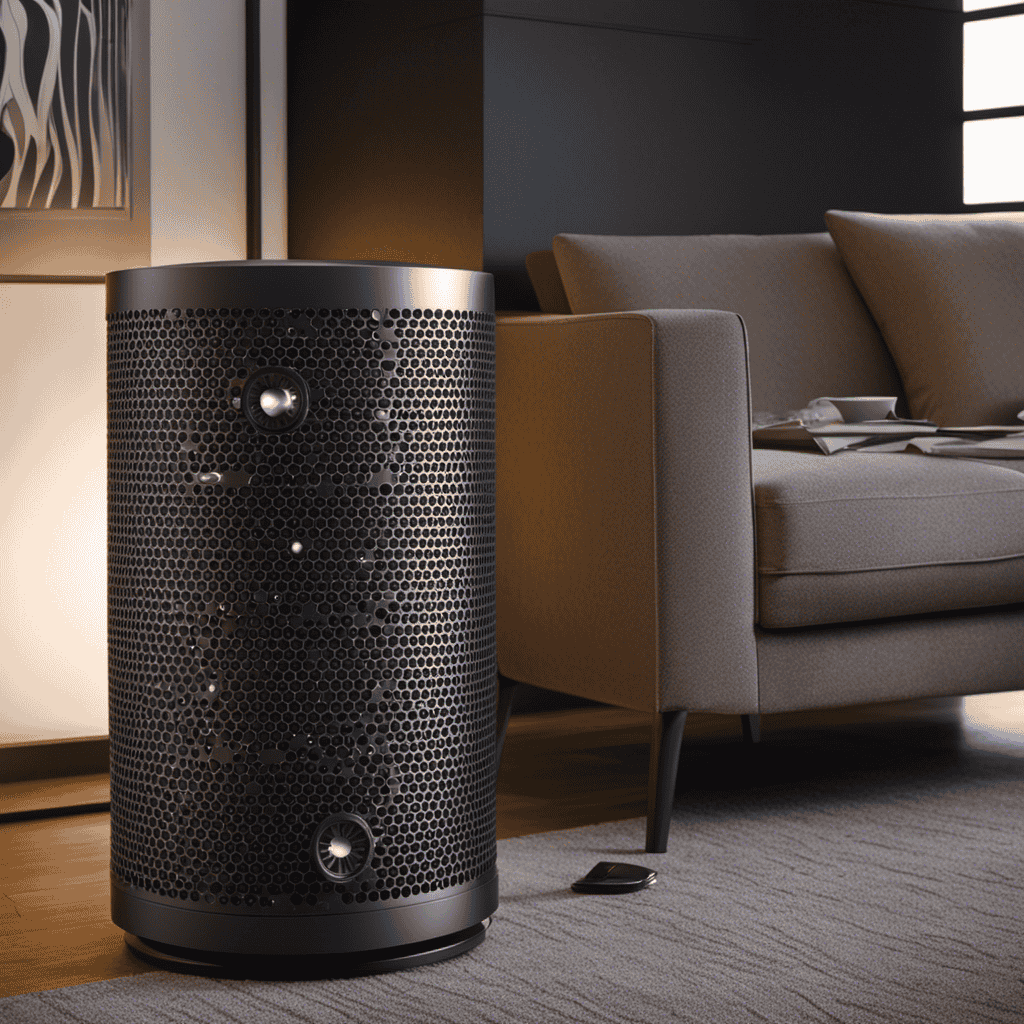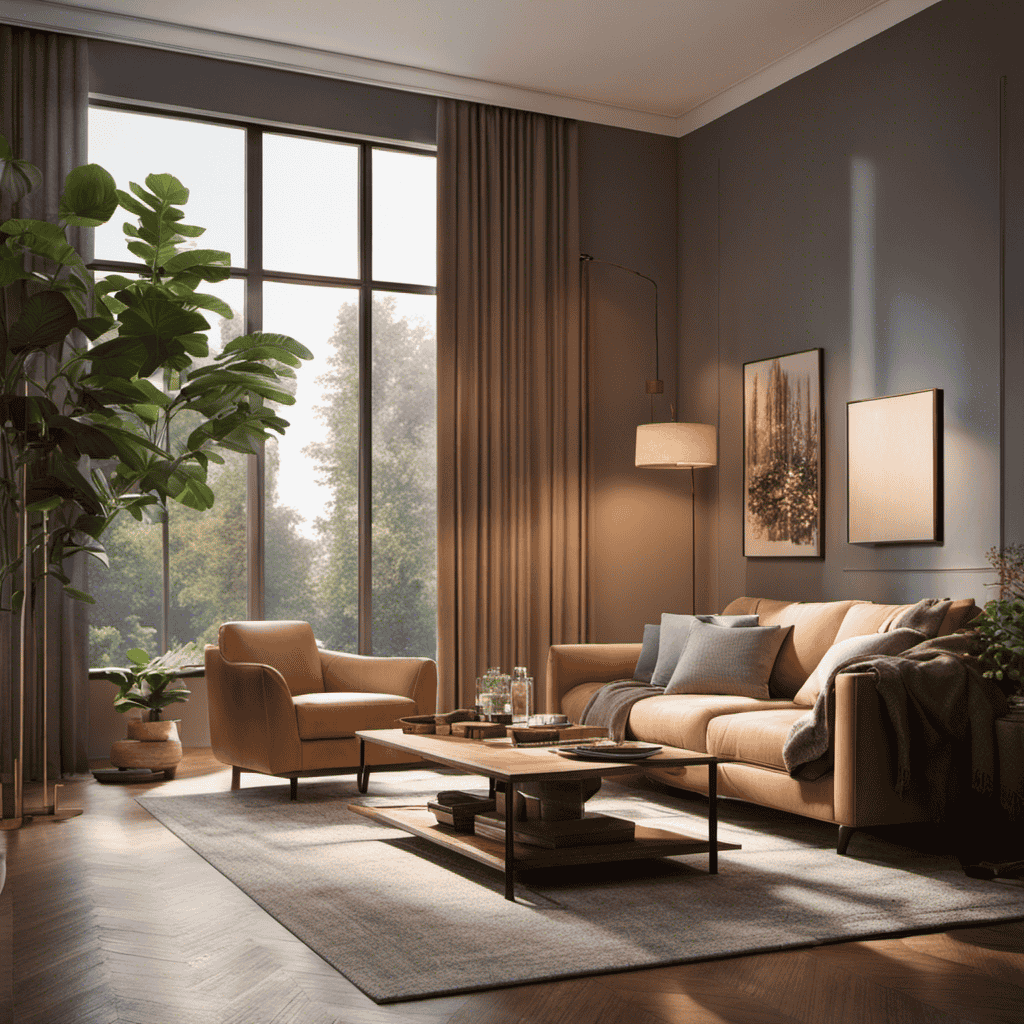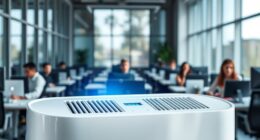As a person who cares deeply about clean air and its effects on our health, I was pleasantly surprised to learn that water air purifiers can eliminate nearly 99% of pollutants from the air in our residences.
This technology, which has gained popularity in recent years, uses water as a filter to trap and eliminate harmful particles, such as dust, allergens, and even bacteria.
In this article, I will delve into the inner workings of water air purifiers, explain their benefits, and explore how they compare to other types of air purifiers.
Key Takeaways
- Water air purifiers use water as a filter to trap and eliminate pollutants from the air.
- They utilize a combination of filtration and humidification processes to improve air quality.
- Water air purifiers effectively remove dust, pollen, pet dander, and other contaminants.
- They also increase humidity levels, alleviating symptoms of dry skin and respiratory issues.
The Basics of Water Air Purifiers
If you’re wondering how water air purifiers work, they use a simple yet effective process to clean the air in your home. These purifiers utilize water as the primary medium for trapping and removing impurities from the air.
As the air passes through the purifier, it is drawn towards the water, where pollutants such as dust, allergens, and odors are trapped and dissolved. This process helps to improve the overall air quality by removing harmful particles and neutralizing unpleasant odors.
However, it is important to understand the drawbacks and maintenance requirements of water air purifiers. One drawback is that they can be bulky and require a significant amount of space. Additionally, regular maintenance is necessary to prevent the growth of bacteria or mold in the water tank.
Understanding these drawbacks and maintenance requirements is essential for ensuring the optimal performance of water air purifiers.
Now, let’s delve deeper into understanding the technology behind water air purifiers.
Understanding the Technology Behind Water Air Purifiers
To understand the technology behind water air purifiers, you can learn about the process of trapping and removing contaminants from the surrounding air. Water air purifiers utilize a unique combination of filtration and humidification to improve the quality of indoor air. Here are the key steps involved in the technology:
-
Contaminant capture: The purifier draws in air through an intake vent, which then passes through a series of filters. These filters are designed to trap various particles, such as dust, pollen, pet dander, and even bacteria or viruses.
-
Water filtration: Once the air is filtered, it enters a water reservoir within the purifier. The water acts as a secondary filtration system, trapping additional particles and pollutants that may have escaped the initial filters.
-
Humidification: As the air passes through the water reservoir, it becomes humidified. This helps to alleviate dryness in the air, which can lead to discomfort, dry skin, and respiratory issues.
-
Release of clean, humidified air: Finally, the purified and humidified air is released back into the room, creating a healthier and more comfortable indoor environment.
The technology behind water air purifiers offers several benefits, including improved air quality, reduced allergens, and increased humidity levels, making it an effective solution for those seeking cleaner and healthier indoor air.
Benefits of Using a Water Air Purifier
Using a water air purifier can greatly improve the quality of indoor air. It does this by reducing allergens, increasing humidity levels, and providing a cleaner and healthier environment.
Compared to traditional air purifiers, which use filters to trap particles, water air purifiers utilize a different mechanism. They work by drawing in air and passing it through a water chamber where impurities are captured and trapped in the water. This process effectively removes dust, pollen, pet dander, and other airborne contaminants.
Additionally, water air purifiers have the added benefit of increasing humidity levels. This can alleviate symptoms of dry skin, irritated eyes, and respiratory issues. By creating a clean and moist environment, water air purifiers promote better respiratory health and create a more comfortable living space.
Key Components of a Water Air Purifier
As I delve into the discussion on the subtopic about the key points of the water filtration process and the benefits of water purification, it is imperative to understand the technical aspects of this system.
The water filtration process involves the removal of impurities and contaminants from water, ensuring its safety for consumption. By utilizing various methods such as sedimentation, filtration, and disinfection, water purification offers numerous benefits including improved health, enhanced taste, and safeguarding against waterborne diseases.
Water Filtration Process
The water filtration process in an air purifier removes impurities and contaminants from the air. This process is essential for ensuring clean and healthy air in your environment.
Here’s how the water filtration method works:
- Water intake: The air purifier draws in air through an intake vent.
- Water filtration: The air passes through a water chamber where impurities and contaminants are trapped in the water.
- Sediment removal: Larger particles settle at the bottom of the water chamber.
- Disinfection: Some air purifiers use UV light or other methods to kill bacteria and viruses present in the water.
The water filtration method in an air purifier offers several benefits. It effectively removes dust, pet dander, pollen, and other allergens from the air, providing relief to allergy sufferers. It also helps eliminate odors and smoke particles, improving the overall air quality. The clean air promotes better respiratory health and reduces the risk of respiratory illnesses. With the water filtration process, you can enjoy fresh and pure air in your space.
Now let’s explore the benefits of water purification in more detail.
Benefits of Water Purification
Now that we understand how the water filtration process works in a water air purifier, let’s explore the benefits and advantages of water purification.
Water purification offers numerous health benefits that make it a popular choice for improving the quality of the air we breathe. Firstly, water purifiers remove harmful pollutants and allergens from the air, reducing the risk of respiratory issues such as asthma and allergies. By eliminating these contaminants, water purifiers create a cleaner and healthier environment, especially for individuals with respiratory conditions.
Additionally, water purification helps to control humidity levels, preventing the growth of mold and mildew which can cause respiratory problems and other health issues. Furthermore, water purifiers also eliminate unpleasant odors, creating a more pleasant and fresh-smelling indoor environment.
Overall, the advantages and health benefits of water purification make it a valuable addition to any living space.
How Water Air Purifiers Remove Pollutants From the Air
You’ll be amazed at how water air purifiers effectively remove pollutants from the air. These innovative devices use water as a filtration medium to capture and eliminate various types of contaminants.
Here’s how they work:
-
Water curtain: The air is drawn into the purifier and passes through a water curtain, which acts as a physical barrier. This curtain traps larger particles such as dust, pollen, and pet dander.
-
Ionization: The purifier releases negative ions into the air, which attach to positively charged particles like allergens and odors. This process causes these particles to become heavier and fall out of the air.
-
Germicidal UV light: Some water air purifiers also incorporate UV light to kill bacteria and viruses that may be present in the air or water.
-
Activated carbon filter: Finally, the purifier utilizes an activated carbon filter to adsorb and trap smaller particles and odors, leaving the air fresh and clean.
Water air purifiers offer a unique and effective way to remove allergens and eliminate odors, making them an excellent choice for improving indoor air quality.
The Role of Water in Air Purification
Water plays a crucial role in air purification as it acts as a natural filter, effectively removing pollutants and contaminants from the air. As air passes through water, impurities such as dust, allergens, and smoke particles become trapped and dissolved in the water.
Additionally, water air purifiers provide the added benefit of humidifying the air, which can help alleviate respiratory issues, promote healthy skin, and reduce static electricity.
Water as Natural Filter
Using water as a natural filter, an air purifier removes impurities from the air. This process is known as water filtration and it plays a crucial role in ensuring clean and fresh air in our surroundings.
Here are four key ways in which water acts as a natural filter in an air purifier:
-
Trapping particles: As air passes through the purifier, water droplets capture and trap larger particles like dust, pollen, and pet dander suspended in the air.
-
Humidifying the air: Water in the purifier adds moisture to the air, preventing dryness and improving overall air quality.
-
Neutralizing odors: Water molecules absorb and neutralize unpleasant odors, leaving behind a fresh and clean scent.
-
Reducing airborne pathogens: Water filtration can help in reducing the presence of bacteria, viruses, and other harmful microorganisms in the air.
Humidifying Benefits of Water
To increase the moisture in the air and improve air quality, simply let the air purifier with water filtration do its job. Water air purifiers, also known as humidifiers, are designed to add moisture to the air through the process of evaporation. This technology not only helps to alleviate dryness in the environment but also provides several health benefits.
Humidifier health benefits include soothing dry skin, reducing respiratory symptoms, and preventing the spread of airborne viruses. The water in the air purifier acts as a natural filter, trapping impurities such as dust, pollen, and pet dander. This helps to improve air quality and reduce allergy symptoms. Additionally, the increased humidity in the air can help relieve symptoms of dry throat, nasal congestion, and dry eyes.
By using water air purifier technology, you can create a more comfortable and healthier indoor environment for yourself and your family. Check out the table below for a quick overview of the humidifying benefits of water:
| Humidifying Benefits of Water |
|---|
| Soothes dry skin |
| Reduces respiratory symptoms |
| Prevents airborne viruses |
| Improves air quality |
| Relieves dry throat and congestion |
Incorporating a water air purifier into your home or office can have numerous positive effects on your health and well-being. So why not let the water do its job and enjoy the benefits of a humidified environment?
Maintenance Tips for Water Air Purifiers
Make sure you regularly clean the water air purifier to ensure optimal performance and prevent the build-up of contaminants. Here are some tips for cleaning and troubleshooting common issues:
-
Remove the water tank: Carefully detach the water tank from the purifier unit, making sure to follow the manufacturer’s instructions.
-
Clean the tank: Use warm soapy water to clean the tank thoroughly, removing any residue or mineral deposits that may have accumulated.
-
Replace filters: Check the filters regularly and replace them as recommended by the manufacturer. This will help maintain the efficiency of the purifier and ensure clean air.
-
Check for leaks: Inspect the unit for any signs of leaks or damaged parts. If you notice any issues, contact customer support for guidance on how to resolve them.
Comparing Water Air Purifiers to Other Types of Air Purifiers
When comparing water air purifiers to other types of air purifiers, you’ll find that they offer unique benefits and features.
In terms of effectiveness, water air purifiers are highly effective at removing airborne particles and pollutants from the air. The water acts as a filter, trapping dust, allergens, and other contaminants, effectively purifying the air.
Additionally, water air purifiers can also humidify the air, which is beneficial for those living in dry climates or suffering from respiratory issues.
In terms of cost comparison, water air purifiers may initially be more expensive than other types of air purifiers. However, they require less frequent filter replacements, resulting in long-term savings.
Overall, water air purifiers provide effective air purification and additional benefits like humidity control, making them a worthwhile investment.
Common Misconceptions About Water Air Purifiers
Don’t overlook the common misconceptions about water air purifiers. In order to understand the effectiveness debate, it is important to address these misconceptions.
Here are four commonly misunderstood aspects of water air purifiers:
-
Water air purifiers are not just glorified humidifiers. They work on a completely different principle of air purification.
-
Contrary to popular belief, water air purifiers do not eliminate all types of pollutants. They are most effective at removing larger particles like dust and pollen.
-
Some people assume that water air purifiers consume excessive amounts of water. However, they actually use minimal water and operate efficiently.
-
There is a misconception that water air purifiers are noisy. In reality, they are designed to operate quietly, ensuring a peaceful environment.
Understanding these misconceptions is crucial when considering the effectiveness of water air purifiers.
Now, let’s explore the factors to consider when choosing a water air purifier.
Factors to Consider When Choosing a Water Air Purifier
When it comes to selecting a water air purifier, there are several key factors that need to be considered.
Firstly, the size of the purifier should match the size of the room it will be used in, ensuring optimal performance.
Secondly, the filtration system and its effectiveness in removing contaminants should be thoroughly evaluated.
Lastly, maintenance requirements, such as filter replacement frequency and ease of cleaning, should be taken into account to ensure the longevity and efficiency of the purifier.
Key Selection Factors
To choose the right water air purifier, you should consider key selection factors. Here are the top four features to look for in a water air purifier:
-
Filtration System: Look for a purifier with a multi-stage filtration system that includes activated carbon and HEPA filters. This ensures effective removal of pollutants, allergens, and odors from the air.
-
Coverage Area: Consider the size of the room you want to purify. A purifier with a larger coverage area will be more efficient at cleaning the air in larger spaces.
-
Noise Level: Check the decibel rating of the purifier. Look for models that operate quietly, especially if you plan to use it in a bedroom or office.
-
Maintenance and Cost: Consider the cost of replacement filters and how often they need to be changed. Also, check if the purifier requires any additional maintenance, such as regular cleaning or water refilling.
Performance and Maintenance
Maintenance is important when considering a water air purifier’s performance. The effectiveness of a water air purifier relies heavily on regular cleaning and proper maintenance.
Cleaning methods for water air purifiers typically involve removing and cleaning the water tank, replacing or cleaning the filter, and disinfecting the unit. It is crucial to follow the manufacturer’s instructions for cleaning and maintenance to ensure optimal performance.
Effective maintenance also includes regularly checking and replacing any worn-out or damaged parts, such as the motor or fan. Neglecting maintenance can result in reduced performance, decreased air quality, and even potential health hazards.
Real-Life Examples of Water Air Purifiers in Action
Water air purifiers, like the popular brand Airocide, have been successfully used in hospitals to eliminate airborne pathogens and reduce the risk of infection.
Here are some real-life examples of how water air purifiers have benefited different environments:
-
Homes: Imagine coming home to fresh, clean air, free from allergens and pollutants that can trigger respiratory issues. With a water air purifier, you can create a healthy living space for you and your family.
-
Offices: Picture a productive work environment where employees breathe in purified air, resulting in improved focus and overall well-being. Water air purifiers can help create a healthier workspace, reducing sick days and increasing productivity.
-
Schools: Visualize classrooms filled with fresh air, promoting better concentration and learning. Water air purifiers can help create a healthier educational environment, benefiting both students and teachers.
-
Restaurants: Envision a dining experience where customers can enjoy their meals in a clean and odor-free atmosphere. Water air purifiers can help eliminate cooking odors and contaminants, providing a pleasant dining experience.
These real-life examples demonstrate the benefits of water air purifiers in various settings, improving air quality and promoting a healthier living and working environment.
Frequently Asked Questions
Can Water Air Purifiers Remove Cigarette Smoke and Its Odor From the Air?
Yes, water air purifiers can effectively remove cigarette smoke and its odor from the air. Unlike traditional air purifiers, water air purifiers use water as a filtration method. They require regular maintenance to clean and refill the water tank.
Are Water Air Purifiers Effective in Reducing Allergens Like Pollen and Pet Dander?
Water air purifiers, unlike HEPA air purifiers, can effectively reduce allergens such as pollen and pet dander. They don’t just purify the air, but also provide humidity, creating a healthier and more comfortable environment.
Will a Water Air Purifier Help in Reducing Mold and Mildew Growth in the Home?
Yes, a water air purifier can help reduce moisture levels and prevent the spread of mold and mildew in the home. It works by capturing airborne particles and trapping them in water, effectively removing them from the air.
How Often Should the Water in a Water Air Purifier Be Changed?
Changing the water in a water air purifier regularly is essential for optimal performance. It helps maintain the purifier’s efficiency and ensures that it continues to effectively remove impurities from the air.
Can Water Air Purifiers Eliminate Volatile Organic Compounds (Vocs) From the Air?
Water air purifiers can eliminate volatile organic compounds (VOCs) from the air without releasing any harmful byproducts. They can also be used in commercial spaces to improve indoor air quality effectively.
Can a Water Air Purifier Work the Same Way as a Traditional Air Purifier?
Yes, a water air purifier can work in a similar way as a traditional air purifier. The air purifier functioning explained is that both types of purifiers aim to remove contaminants from the air, such as dust, allergens, and odors. However, water air purifiers use water as a filter instead of traditional filters.
Conclusion
In conclusion, water air purifiers are an innovative and efficient solution for improving indoor air quality. With their unique technology, they act as a refreshing oasis amidst a polluted desert.
By using water as a filtration medium, they effectively trap and eliminate airborne pollutants, leaving behind clean and healthy air.
When considering a water air purifier, it is important to evaluate factors such as size, maintenance requirements, and filtration efficiency.
So, let your home breathe in the freshness of a water air purifier, rejuvenating your surroundings like a cool breeze on a sweltering day.










